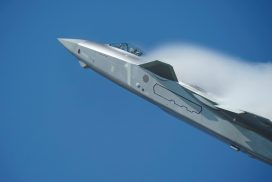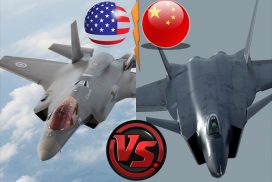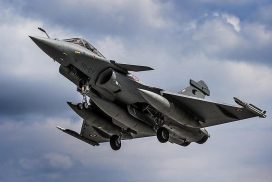China’s air superiority is rapidly mobilizing in the light of modernization of Chinese fighter jets, cargo planes, stealth aircraft, missiles and launch vehicles. Reports suggest that the People’s Liberation Army Air Force (PLAAF) currently has approximately 3,000 operational aircraft, nearly 600 of which are considered modern.
Recent flights of prototypes of the Chinese J-20 stealth fighter, an aircraft more advanced than any other air platform currently deployed in the Asia-Pacific region, provide testament to their superior Air Force regarding stealth aircraft. According to some reports, the Chinese are also testing a smaller stealth fighter variant called the FC-31. Today, China’s J-10 fighter jet aircraft would be roughly equivalent in capability to an upgraded U.S. F-15.
Alongside their advanced J-10 fighter aircraft, the Chinese also possess Russian-built Su-27s and Su-30s and are considering the purchase of the new Su-35 from Russia. These versatile, highly capable aircraft would offer significantly improved range and fuel capacity over China’s current fighters, thus strengthening China’s ability to conduct air superiority missions in the Taiwan strait, East China Sea, and South China Sea.
Such aircraft will also provide China with the opportunity to reverse engineer the fighter’s component parts, including advanced radar and engines, for integration into China’s current and future indigenous fighters. In addition to improved stealth technology, high-tech fighter aircraft and superior avionics, the Chinese have upgraded their ability with a number of sophisticated short and medium-range air-to-air missiles. This includes precision-guided munitions, all-weather satellite-guided bombs, anti-radiation missiles, laser-guided bombs, long-range advanced air-launched land attack and anti-ship cruise missiles.
Sources also suggest that Russia has approved the sale of its new, next-generation S-400 surface-to-air missile to China. The S-400 would more than double the range of China’s air defenses from approximately 125 to 250 miles – enough to cover all of Taiwan, the Senkaku Islands, and parts of the South China Sea.
Other countries have emphasized that while working toward peace and stability, they must nevertheless modernize and prepare their military based upon Chinese capability rather than Chinese intent. It is clear that countries in the region and beyond have to prepare for the rapid progress, expansion and modernization of the Chinese People’s Liberation Army.
Here is a list of China’s most impressive weapons that we should keep an eye on.
1 – WU-14 / DF-ZF Hypersonic Glide Vehicle

The DF-ZF Hypersonic Glide Vehicle (HGV), previously designated as the WU-14, is a Chinese experimental hypersonic missile delivery vehicle that is currently being flight tested. The Chinese Defense Ministry has confirmed that the tests were scientific in nature, although it is widely viewed as part of the Chinese military build-up.
All the test launches were performed at the Taiyuan Satellite Launch Center in Shanxi Province, the main long-range missile testing centre for the People’s Liberation Army. The DF-ZF HGV is claimed to reach speeds between Mach 5 and Mach 10 (i.e., between 6,173 km/h and 12,359 km/h). It can be used for nuclear weapons delivery or to perform precision-strike conventional missions, which can penetrate layered air defences of an opposing carrier strike group
The DF-ZF is almost impossible to intercept by conventional missile defence systems, which track incoming objects via satellite sensors and ground sea radar. The only drawback of the Chinese DF-ZF program, however, is a lack of high-performance computing power which greatly limits its design characteristics.
Countering ballistic missiles and warheads by opposing missile defence systems is only possible when they follow a predictable trajectory. The DF-ZF is capable of maneuvering during flight while traveling at the edge of space, and so is extremely difficult to intercept. However, analysts have stressed the DF-ZF is primarily a defensive and not an offensive weapon, although it is capable of carrying nuclear warheads.
China maintains that most of the South China Sea is its own, but there are overlapping claims with the Philippines, Brunei, Malaysia, Taiwan and Vietnam. The DF-ZF will serve well as deterrence against aggressive forces in the region, with the prospect of strategic bombardment if the need ever arises. These countries may, therefore, have to place more importance on developing directed-energy weapons as a countermeasure.
2 – Chengdu J-20 ‘Mighty Dragon’ stealth fighter jet
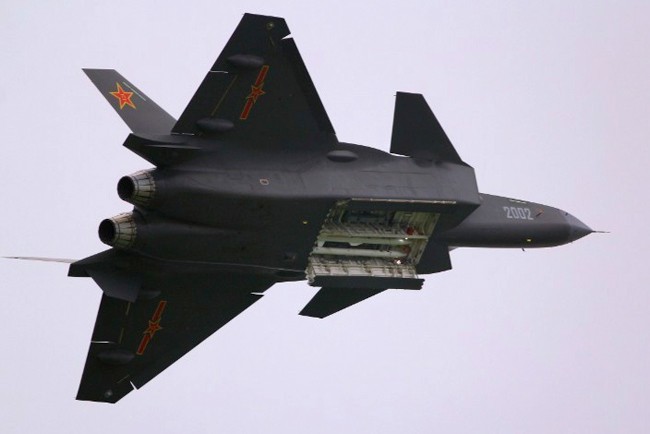
The Chengdu J-20 is a 5th generation, twin-jet, stealth, fighter aircraft prototype currently being developed by China’s Chengdu Aerospace Corporation for the People’s Liberation Army Air Force. It is expected to become operational in 2018. It has the potential to be a long-range strike system in the Asia-Pacific region and beyond. Reports have suggested that the J-20 has the potential of an air superiority fighter once appropriate engines become available, with an emphasis on forward stealth, high-speed aerodynamics, range, and adequate agility.
The J-20 has undergone high-speed taxiing tests outside the Chengdu Aircraft Design Institute, and successful test flights that included retraction of the landing gear. It has also performed various low-altitude manoeuvres and features a redesigned radome, which is speculated to house an AESA radar, side weapons bay and a missile launch rail.
The prototype reveals a new intake and stealth coating, as well as redesigned vertical stabilizers, and an Electro-Optical Targeting System. It also had noticeable improvements, such as changed DSI bumps on the intakes, designed to save weight, complexity and radar signature. The aircraft’s long and wide fuselage extends almost entirely up to the engine’s exhaust nozzles, with the chiselled nose section and a frame-less canopy reminiscent of the U.S. F-22 Raptor.
Powering the J-20 are advanced 14-ton thrust derivative of the Russian AL-31 or the Chinese WS-10 turbofan engines, although 18-19 tonne WS-15 engines are planned for future prototypes (similar in performance to the Pratt & Whitney F119), which will enable the jet to super-cruise without using afterburners. The engine core, composed of high-pressure compressors, the combustion chamber, and high-pressure turbines have been successfully tested
It features a reshaped cockpit canopy, which provides the pilot with greater visibility. Behind the cockpit are low observable intakes. Trapezoidal flight booms around the engines appear to be enlarged, possibly to accommodate rearward facing radars or electronic jamming equipment. The main weapon bay of the J-20 is capable of housing both short and long-range air-to-air missiles. Two smaller lateral weapon bays behind the air inlets are intended for short-range AAMs.
3 – Jiaolong (Water Dragon) AG600 the world’s largest amphibious aircraft

The first airframe of the AG600 prototype No.001 is currently being assembled at a facility in Zhuhai in Guangdong province and final assembly is expected to be completed with a first flight test to take place around mid-2016. All major parts of the prototype have been delivered to the plant for static tests and the equipment for the test platform is being installed. The 9.5-meter nose assembly alone consists of 5,200 components.
The AG600 is powered by four turboprop WJ-6 engines that provide a range of 5,500 kilometres. The aeroplane measures 36.9 meters long with a wingspan of 38.8 meters and a maximum take-off weight of 60 tonnes. It is capable of carrying up to 50 people and is being designed for marine rescue and forest firefighting with the ability to draw 12 metric tonnes of water in 20 seconds.
The aircraft’s designers proclaim the AG-600 is the world’s largest amphibious plane surpassing Japan’s ShinMaywa US-2 and the Russian-made Beriev BE-200. Malaysia and New Zealand have already expressed interest in the AG-600 because of its capability of landing and taking off both on water and land. This design aspect will be beneficial for countries with many islands.
Defence analysts have observed that the amphibious plane would be perfect for resupplying the new artificial islands that the Chinese are building in the South China Sea. So far 17 domestic orders have been placed for the amphibious aircraft. Further, they have added that these islands would be excellent bases of operations for the AG-600 to engage in maritime patrols of claimed territories. However, Chinese aviation officials have stressed that the plane is also envisioned for export.
The AG-600 will play an important role in forest fire control, maritime search and rescue, personnel and supply transport and law enforcement tasks at sea. With an impressive range of 5,500 kilometres, it can fly a round trip between Sanya in Hainan province and the shoal of Zengmu Ansha, the southernmost point of China’s territory, without refuelling.
4 – CJ-10 Cruise missile
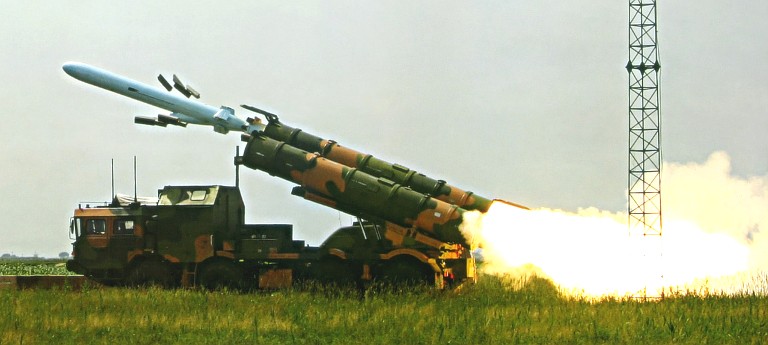
The CJ-10 is a second-generation Chinese ground-launched land-attack cruise missile. It is manufactured by the China Aerospace Science and Industry Corporation Third Academy and the China Haiying Electro-Mechanical Technology Academy. The CJ-10 was initially known as the DH-10 by media and Western analysts.
The supersonic missile has a range of over 1,500 km and 500 kg of either a conventional or nuclear payload. It incorporates a guidance package using inertial navigation system, satellite navigation, Terrain Contour Matching, and a Digital Scene-Mapping Area Correlator for terminal guidance making it harder for defences to jam or deceive the missile. Launch platforms for the missile are ships and ground transporter erector launchers (TEL).
There is a subsonic anti-ship missile version with a range of 800 km . It is capable of an air-launch by the H-6K bomber and JH-7B fighter-bomber, and can be fired from the vertical launch system of the Type 055 destroyer. Foreign technology has heavily influenced the CJ-10, most notably the KH-55 from Ukraine, and unexploded Tomahawks and its parts purchased from Iraq, Pakistan and Serbia.
An estimated 50-250 missile were in Chinese service with the number increasing to 150-350 in recent years. The CJ-10 has low flight altitude characteristics that increase its stealth capabilities against air defence radars. It can also be updated during its flight with new targeting data, allowing it to change targets mid-flight. The stealth capabilities employed by the CJ-10 allows it to confuse or out manoeuvre the radars and defences around ships in the region.
Their fuel-efficient turbofan engines allow the cruise missiles to be lighter and cheaper than their ballistic counterparts. Weighing about 1-1.5 tonnes, the CJ-10’s two retractable wings, four tail-fins and belly mounted engine air intake will all unfold as it flies as far as 1,500km away. Its payload can either be a high explosive warhead or sub munitions for attacking fighters on runways and tank columns, nuclear warheads and fuel air explosives. The CJ-10’s flexibility, large payload and long range make it one of China’s most important strategic weapons.
5 – Xian H-8 stealth bomber
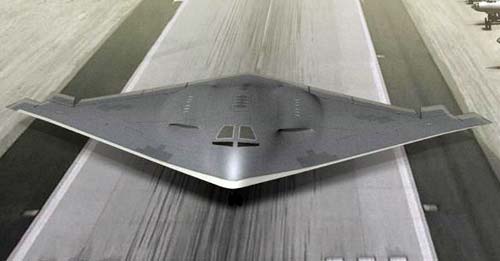
The Xian H-8 stealth bomber is a Chinese military aircraft reported to be the successor to the ageing twin-engined H-6 jet bomber. Initial prototypes by Xi’an Aircraft Factory were enlarged versions of the Xi’an H-6 with 4-engined underwing assemblies, a new attack radar added in the nose, and incorporating capability against sea targets
The aircraft is capable of climbing 40% faster than the Xi’an H-6, and the range has been increased to 8,000 km (combat radius 5,000 km). An increased number of weapons can be carried, including bombs of various sizes, ranging from 100 kg to a massive 9-ton payload, capable of holding a maximum of 18 tonnes. Nuclear armaments can also be carried, as well as anti-ship and land attack missiles, with a third missile semi-buried in the bomb bay. It has a permanent weapon which is a tail gun mount incorporating a twin 23mm gun.
The crew of 6 includes the pilot, co-pilot, navigator and bombardier seated in the forward pressurized compartment while the electronics warfare and tail gunner are seated in the rear compartment which is also pressurized. Avionics relies heavily on reverse engineered American systems obtained from Boeing B-52 and other U.S. aircraft provided by North Vietnam during the Vietnam War.
The Xi’an H-8 is powered by 4 Rolls-Royce Spey MK 512-5W high-bypass ratio turbofan engines which were originally purchased by China as spare engines for Hawker Siddeley Trident 2E civil aircraft.(The Trident was one of the first jet-powered civilian transports acquired by the People’s Liberation Army Air Force.) The fuselage is lengthened to accommodate the engines arranged in individual pods under the wings, two in the wing roots, as well as two more engines on pylons on the wings.
The Xi’an H-8 has a length of 48.50 meters, a height of 13.85 meters and a wingspan of 46.47 meters. Its power-plant of 4 x Shenyang WS-6J turbofan engines allow for a maximum takeoff weight of 163,000 kg and provides a maximum speed of 1,000 km/h. Cruise speed is limited to 800 km/h at low and medium altitudes, and 850 km/h for higher altitudes. Service ceiling is 14,000 meters. It can carry anti-ship and air-to-surface missiles as well as 18,000 kg of free fall bombs.


